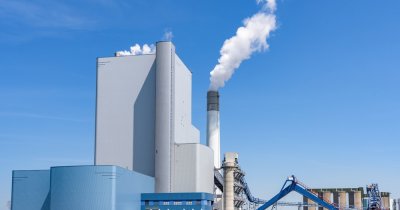Beside those, there is also geothermal energy, a less used type of power that could be a great solution to tackle climate change. But what is geothermal power, how does it work and what can it be used for?
What is geothermal energy
Geothermal energy is a renewable type of power that comes from inside the Earth, more specifically from the exchange in temperatures between and the surface, and it was formed during the early days of the planet, when it was yet to reach its current form.
This type of thermal energy is also continuously formed by the decay of materials that reach the core of the Earth, where they decompose due to the extremely high temperatures of up to 4.000 degrees Celsius, and then get stored in the rocks and fluids in the center of the planet. Very hot matter at the center of the Earth rises to the surface, due to the fact that it is lighter than cooler matter.
The rock and water found in the Earth's crust, at shallow depths and a few kilometers below the planet's surface, can reach temperatures of 370 degrees Celsius, which essentially represents geothermal energy.

The early days of geothermal energy
Geothermal energy is nothing new for humanity, as it was used by some people thousands of years ago during the Paleolithic Age, for practices such as bathing. For example, in North America, the native people used geothermal energy for spiritual practices, but also for medical and practical purposes, such as purification, warming up in the harsh winters and cooking.
In fact, underground geothermal reservoirs are still being used for generating electricity, heating and even cooling systems.
How we harness geothermal power. What countries use it
Geothermal power is being exploited by drilling wells in the ground, 1.6 kilometers deep or more, depending on how far the resources are found.
The geothermal resources can be enhanced, as well, with the help of hydraulic stimulation, in order to improve the productivity of these wells.
Whether natural or enhanced, geothermal power drives special turbines that in return power a generator that creates electric energy.
Larderello, in Italy, was the first city in the world to use geothermal heat in order to produce electricity, starting 1904.
Indonesia and the Philippines are two other countries that exploit geothermal power, while Kenya and Turkey are slowly gaining momentum to become the next users of geothermal resources.
Geothermal energy in Romania
Geothermal energy in Romania is mostly located in the Western side of the country, in the Banat region and near the Apuseni Mountains, and the most important resource of geothermal energy is located in Bihor.
This region exploited geothermal power for a century or so, with the city of Oradea serving about 5.500 homes with regards to heating with geothermal energy, and the city of Beiuș being the only city in the country heated exclusively with geothermal power.
The total geothermal capacity in Romania is about 480 MW, and the country has the third most potential when it comes to geothermal power in continental Europe, after Greece and Italy.

Types of geothermal plants
Geothermal plants come in three main designs, depending on the geothermal power that they harvest, and they can be dry steam powered, flash or binary.
Dry steam geothermal plants are the oldest used, and they work by taking steam from the fractures in the ground to drive the turbines.
Flash geothermal plants take high pressure water from the underground and mix it with cooler, low pressure water, and the process creates the steam necessary in order to move the turbine.
Binary plants pull the hot water from the Earth and passes it through a secondary fluid that has a lower boiling point than water. In the process, the secondary fluid is turned into steam, which in turn drive the turbine.
Binary geothermal plants are thought by some experts to be the future of geothermal energy.
The world's most important geothermal power producer is the United States, where we can find the largest geothermal plant in the world at The Geysers, north of San Francisco, California. The plant has the capacity to produce around 725 megawatts of energy, which should be enough to power 725.000 homes or the city of San Francisco. In 2018, this site provided 50% of the geothermal energy in California.
The name would suggest that the plant uses hot water in order to produce electricity, but in fact, it uses steam to do so.
Iceland is another nation that harnesses geothermal power for its energy necessary, with 26% of the country's total power output coming from geothermal. The people of Iceland exploited geothermal energy since 1907, and with 25 active volcanoes and 600 hot springs, it is easy to see the geothermal potential the country has.
The advantages of geothermal power
First of all, this type of energy is environmentally friendly and less polluting compared to fossil-fuel alternatives, with a low carbon footprint.
Geothermal energy is also sustainable and renewable, and it will last until the day Earth will be gone, which should be around five billion years from now, plenty of time to get the most out of geothermal power.
Just like hydro energy, geothermal is not only sustainable and renewable, but stable as well, with the resources being constantly delivered, unlike solar and wind energy, which count on resources that fluctuate a lot in terms of availability.
Another advantage is the research being done to make geothermal energy more widely available and more efficient, as it is proven to be a great alternative in some areas of the planet compared to fossil-fuel energy sources that are limited in availability and very harmful to the environment.

The drawbacks of geothermal energy
The biggest drawback of geothermal power is that it nowhere near as available as other renewable sources, such as water, solar and wind.
It is in fact one of the most restrictive renewable energy sources out there based on location, and this is why not a lot of countries are interested in it directly, as they lack the resource. But places like Iceland, for example, could make great use of geothermal energy for their own supply.
There are also some environmental side effects when it comes to geothermal energy, related to the release of greenhouse gases. While the process of turning geothermal power into electricity doesn't necessarily release greenhouse gas emissions, extracting it from the ground does, as there are some of those climate warming gases in the Earth crust.
Geothermal plants, especially those that enhance the potential of the energy by forcing water into the crust of the planet, can cause earthquakes, by altering Earth's structure. This shouldn't prove too much of an issue, though, since most geothermal plants are positioned pretty far away from human settlements, such as cities or towns.
Geothermal plants are also very expensive to build, with the cost of a 1 MW plant ranging from 2 to 7 million dollars, however, the initial cost can be recovered in time as a long term investment.
Lastly, companies that harness fluids from the Earth's crust to produce electricity must also pump back those liquids in order to avoid the depletion of resources, as they can't be naturally built back by the planet fast enough for the process to run continuously.
All things considered, geothermal energy is a great renewable and clean source that countries with access to it can harness in order to become more sustainable and help decrease the amount of carbon emissions.
Along with the other types of sustainable and clean energy sources, such as hydro, solar, wind and tidal energy, geothermal power can help us achieve our climate goals, while providing us with electricity and heating.
 Mihai - Cristian Ioniță
Mihai - Cristian Ioniță












Any thoughts?